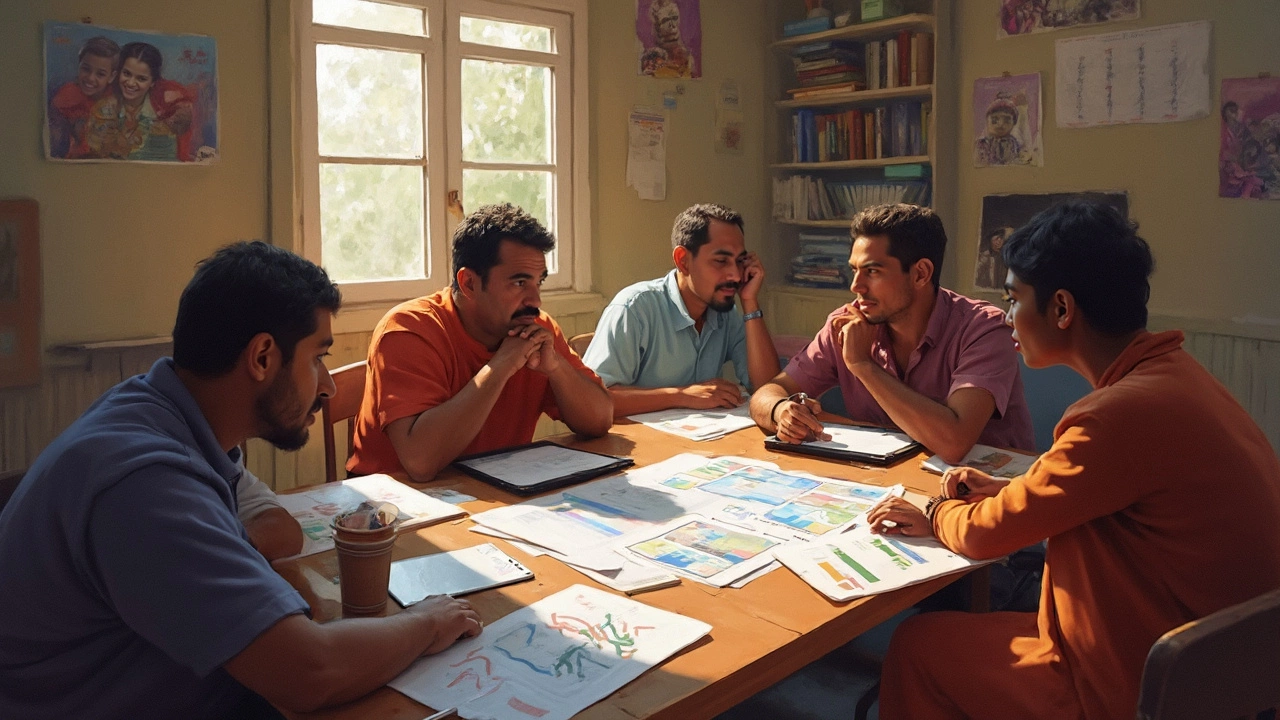If you’re aiming to build an outreach program that does more than just look good on paper, you’ve got to start with the basics: what does your community actually need? Too many groups skip this and end up hustling ideas nobody asked for. Forget the assumption game—walk the block, talk to people, run quick surveys if you have to. You’ll learn more from 10 honest conversations than a whole afternoon scrolling online.
A successful outreach program isn’t built in a bubble. It grows when you bring together people with different skills and real passion for the cause. Whether it’s folks who know the neighborhood, professionals who can handle logistics, or that neighbor who can get 30 people to a meeting with a text message—everyone counts. If you try to do it all solo, burnout isn’t far behind.
- Pinpointing the Real Need
- Building the Right Team
- Setting Clear, Measurable Goals
- Getting the Word Out (and Getting Folks Involved)
- Measuring Impact Without Getting Lost in Numbers
Pinpointing the Real Need
Jumping in without understanding what your neighborhood actually needs is like showing up to a potluck with five bags of chips—nice, but not very helpful if everyone else did the same. You’ve got to get specific. Start by asking yourself, “Who are we trying to help and what’s missing for them?” Don’t just guess. Forbes reported in 2023 that over 60% of outreach efforts flop because they’re solving problems people don’t care about.
Go straight to the source. Chat with people at local hangouts, at events, at the bus stop. You’re not looking for a full-blown interview, but real, honest answers. Sometimes what seems like the main problem from the outside isn’t even in the top three for the folks living there.
Here’s a simple approach that actually works:
- Do a quick survey—online, on paper, or just by talking to people in person.
- Ask open questions like, “What do you wish our neighborhood had more of?” or “What’s something that would make your week easier?”
- Notice who you’re missing—are you only hearing from the loudest voices?
- Look at city data: Local government sites often have stats on school attendance, crime, food access, or whatever you’re tackling.
Pull all this info together, then check for patterns. Are most folks asking for after-school help, food banks, or maybe just a place to gather? If you keep hearing the same answer, that’s your target. This sharp focus is what turns an outreach program from a nice idea into something that actually moves the needle. Skip this step, and you’re just spinning your wheels (and probably wasting money and time).
Building the Right Team
You can have the best outreach idea out there, but without the right people, it just won’t take off. The first step is looking beyond your own friends or regular volunteers. Think about which skills are actually needed for your project to work. Most solid outreach programs have folks covering these bases:
- Someone who knows the local area and can spot quick wins or real hang-ups.
- A communicator—someone who can get people excited, explain things simply, and rally support.
- An organizer who can juggle schedules, contacts, and logistics without dropping the ball.
- Someone with a head for numbers—keeping track of funding, supplies, and what’s coming next.
- The ‘people magnet’—there’s always one person who seems to know, or be able to reach, almost everyone.
When picking your team, think diversity—age, background, even experience level. Sometimes, the most helpful feedback comes from people who don’t fit the usual crowd. In fact, a study from Stanford in 2023 showed that community groups with broader backgrounds solved problems 20% faster. Different perspectives spot obstacles before they turn into disasters.
Once you’ve found these folks, don’t just toss them a task list. Hold a short meeting, lay out what you’re aiming for, and ask everyone to speak up—what do they want to do, and what are they comfortable handling? It makes things smoother and gets people truly invested from day one. Remember, for a outreach program to run well, you need a team that trusts each other and feels their input matters.
Stick with the people who show up and follow through. If someone’s more about talk than action, address it early—one person not pulling their weight can really slow things down. Checking in regularly, even with a casual text or call, keeps motivation high without getting all corporate and cold.

Setting Clear, Measurable Goals
This is where a lot of outreach programs fumble. It’s easy to get excited and say, “We want to help!”—but what does that mean, exactly? If you can’t track progress, how do you know your outreach program actually works? Start by setting goals that are specific, realistic, and tied to your main mission. Don’t just shoot for ‘raise awareness’; decide if you want to have 200 people at your community meal, deliver 100 care packages, or get 50 new kids signed up for after-school programs.
Here’s a checklist that helps you nail down clear goals:
- Make the goal specific (e.g. “Register 30 new volunteers for food drives by August” instead of just “get more volunteers”)
- Set a number or target that you can measure
- Add a deadline
- Make sure the goal actually matters for your team and the folks you want to help
- Write it down—literally post it where your team meets
Need a real-world example? The American Red Cross tracks success by the number of blood drives held and units collected every quarter. It’s no secret—clear numbers keep everyone honest and motivated.
| Type of Goal | Bad Example | Good Example |
|---|---|---|
| Volunteers | Get more helpers | Recruit 20 new volunteers by July 31 |
| Attendance | Host an event | Reach 150 attendees at summer job fair |
| Impact | Help people | Distribute 500 meals in 3 months |
Most nonprofits that set measurable targets see up to a 40% better follow-through rate than those that keep goals vague, according to a 2023 sector report from VolunteerMatch. If you want your outreach program to stick, make every target clear, put someone in charge, and check results along the way. That’s how you move from good intentions to real impact.
Getting the Word Out (and Getting Folks Involved)
You can have the best idea for an outreach program, but if nobody hears about it or feels welcome, it’s going nowhere fast. Getting the word out isn’t just about posting a flyer or sending a mass email. You need a real plan that covers where people actually hang out—both online and in real life.
Start with the basics: mix old-school with digital. Peel-and-stick flyers in laundromats actually still work, especially in small towns. Social media posts can reach people fast, but only if you cut the jargon and keep it real. There’s no need to toss out big words; just explain what the program is, who it helps, and how folks can jump in.
- Local Facebook groups: Neighborhood and city-focused Facebook groups see tons of daily traffic. Post with a personal touch.
- WhatsApp or Telegram chats: Many communities now use group chats (even for apartment buildings!).
- Local radio stations and community newsletters: Research from the Pew Research Center shows 41% of adults still get local info from radio.
- Local businesses: Ask shops, gyms, or cafes to display event flyers or info cards at the register.
In-person word-of-mouth still packs a punch. Find those natural “connectors”—the friendly neighbor, the barber, the crossing guard that everyone knows. One direct invitation from them beats ten emails any day.
Breaking the involvement barrier is about offering roles, not just needs. Instead of “We need volunteers,” get specific: “Can you help set up tables on Saturday?” or “Would you like to bake cookies for our welcome booth?” Make folks feel their skills matter.
Let’s throw in some real numbers to show what works for different methods of spreading the word. A survey by VolunteerMatch in 2023 showed:
| Outreach Method | Avg. Response Rate (%) |
|---|---|
| Personal Invitation | 56 |
| Social Media Post | 25 |
| Email Newsletter | 14 |
| Flyers in Public Places | 10 |
The takeaway? Personal touches get more people on board, but layering your efforts means you won’t miss groups who never check their inbox or who aren’t scrolling Instagram every five minutes.
For a community engagement outreach to work, always remove barriers to joining. Offer childcare if you can, host events after work hours, provide food, or give transit tips. Little things turn “just curious” into “count me in.”

Measuring Impact Without Getting Lost in Numbers
This is where most community outreach projects start sweating. Numbers get tossed around, graphs look impressive, but is anything actually changing? The only way to know is to keep it simple and focus on what really matters for your outreach program.
Instead of counting every little thing, first ask: what outcome would mean 'success' to the people you’re trying to help? Maybe it’s 20 more kids getting weekly meals. Or a 30% drop in missed doctor appointments. Nail that goal down before you ever open a spreadsheet.
Once you’ve figured out your outcomes, stick to two or three key ways to measure them. Here’s a quick rundown of what’s worth tracking:
- Number of people actually helped, not just signed up
- Changes in behavior or life situation (school attendance, job placement, etc.)
- Feedback from the people your program serves—were their needs met?
Feedback matters. In 2024, a survey by Community Tool Box found that 62% of successful outreach efforts relied on regular feedback to make real adjustments—not just afterthought surveys. Don’t rely on guesswork—ask simple, clear questions like “Did we help solve your actual problem?” or “What was missing?”
It’s easy to get tangled up in stats, so stick with a basic tracking chart. Here’s a sample table showing what you might use for a youth literacy program:
| Month | Kids Enrolled | Improved Reading Level (%) | Parent Satisfaction (%) |
|---|---|---|---|
| January | 50 | 40 | 80 |
| February | 60 | 45 | 85 |
| March | 65 | 50 | 88 |
Review these numbers every month with the team—and actually talk about what’s working and what’s not. If enrollment goes up but reading scores flatline, it’s clear where to put your energy next.
And don’t feel pressured to over-report for funders or social media. Honest, clear updates—plus a few great stories from people you’ve helped—beat a hundred overblown graphs every time.
